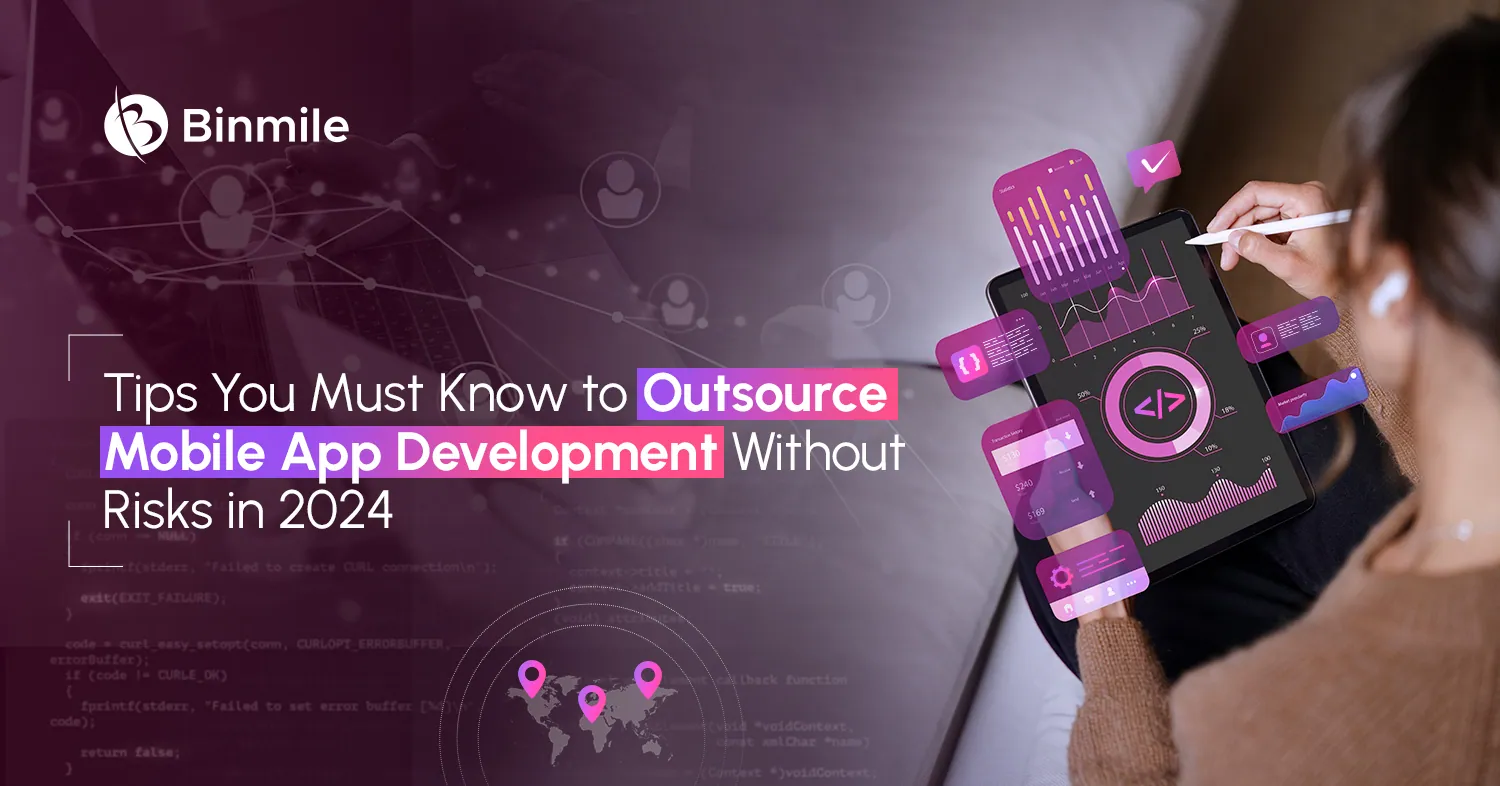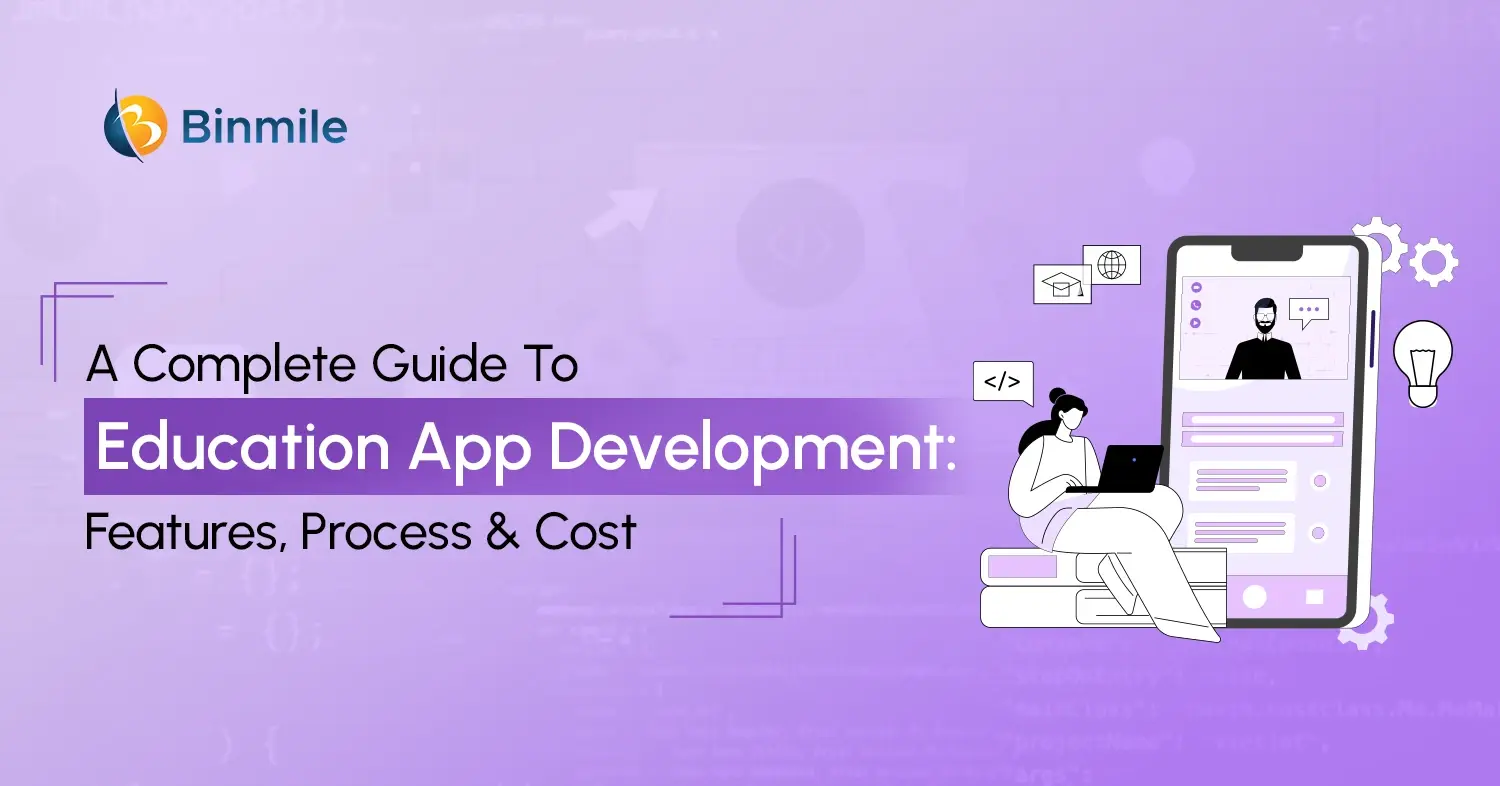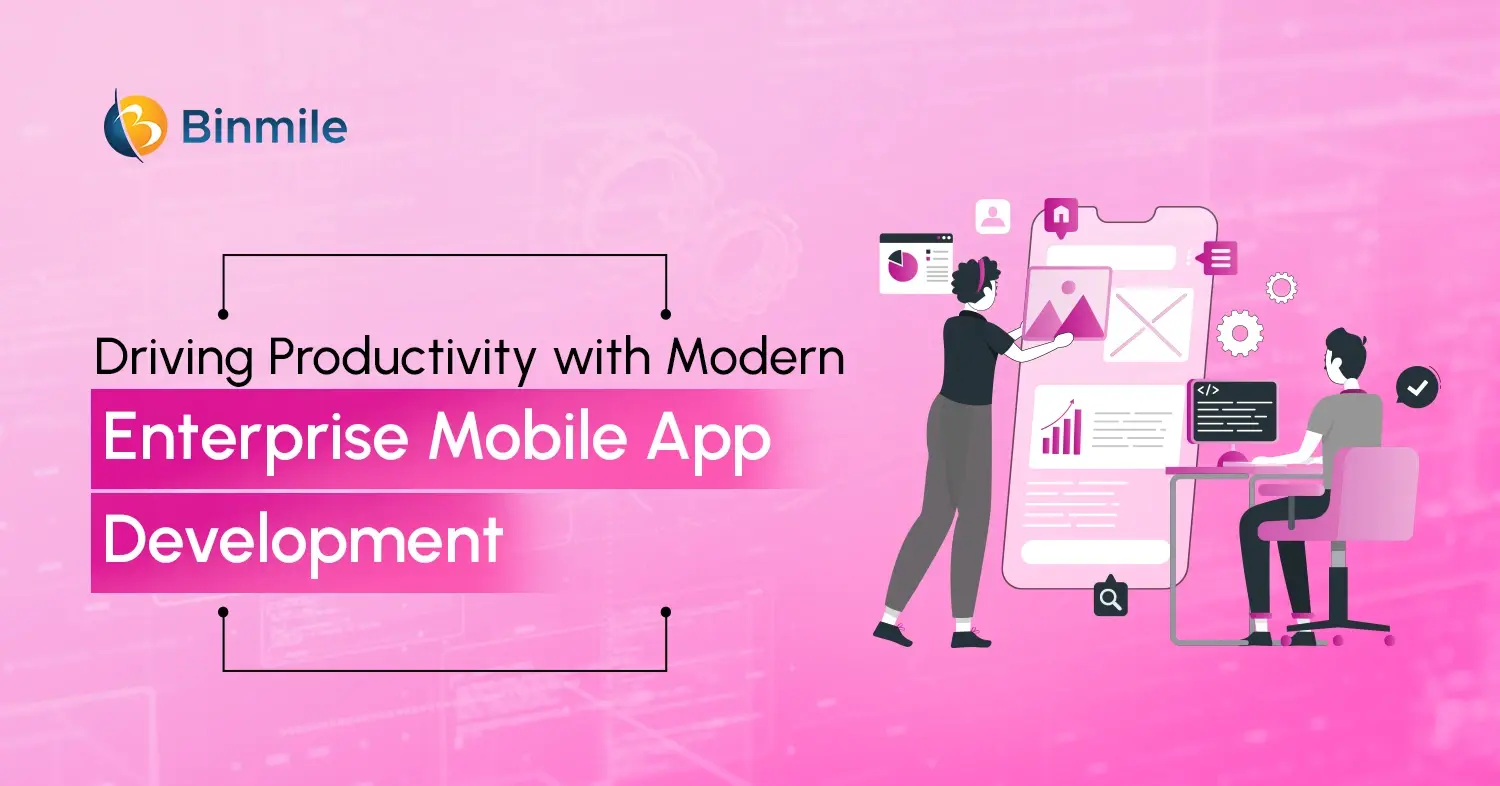With 8.93 million mobile apps available online, the demand for mobile app development services continues to exponentially grow. Naturally, developing engaging mobile apps is the logical next step for your business. This is to expand, boost efficiency, or target new customers, you might consider either to outsource mobile development or managing app development services internally. However, choosing either isn’t without challenges. Maintaining an in-house mobile app development team as opposed to outsourcing it to specialized service providers is still seen as not a favorite choice for several reasons.
On the one hand, gaining control over a project is a tempting reason but it comes with several adverse expenses, including tens of thousands or even millions of dollars for a single app. Having said that, training an in-house IT team may increase app development cost and time but it does involve fewer risks such as quality control, miscommunication, or confidentiality which are there with outsourcing development. Despite this, outsourcing your mobile app to a specialized software outsourcing companies outweighs any disadvantages. The primary reasons are global access to the expertise of the top 1% of tech talent but also cost savings and a faster time to market. Moreover, the road to outsource mobile app development doesn’t have to be a daunting task. With a few best practices and key metrics in outsourcing, you can fully leverage all the benefits outsourcing has to offer with minimal risk of cost or other challenges.
Ready? Let’s dive in!
Smooth and Secure Outsource Mobile App Development Guide: 6 Key Considerations
Outsourcing mobile app development can be a strategic decision, offering access to specialized skills, cost reduction, and faster time-to-market. However, navigating the process can feel daunting. Once you’ve clearly defined your app requirements and are wondering how to outsource mobile app development to the right vendor. Here are 5 key tips to minimize risks and ensure a successful outsourced app development project:

1: Careful Vendor Selection
Finding the right outsourcing partner is crucial as the success of your software development project depends a lot on the partner you’re deciding to work with. Conduct thorough research that includes:
- Contact past clients to get firsthand insights into the development company’s work ethic and communication style.
- Ensure the development team possesses the specific skills required for your project (e.g., expertise in a particular programming language or framework).
- Consider time zone differences and communication preferences to ensure smooth collaboration.
- Get clear quotes outlining project phases, deliverables, and potential additional costs.
2: Protect Your Business Interests
Once you’ve found the right outsourcing partner, review the contract with them. This is a critical step to protect your interests and ensure a smooth development process. Here’s what to pay close attention to:
- Ensure the contract clearly defines the project scope, including deliverables, timelines, and functionalities.
- Avoid vague language that could lead to misunderstandings.
- Specify payment terms, including milestones, deliverables tied to payments, and the total project cost.
- Consider a phased payment structure with milestones to manage risk.
- Include a Non-Disclosure Agreement (NDA) to protect your confidential information, such as app concepts, designs, and user data.
- Outline the process for resolving disputes that may arise during the project. Consider including arbitration clauses for efficient conflict resolution.
3: Secure Your Intellectual Property
Your app’s intellectual property (IP) is vital. Before sharing any confidential information, having a legally binding contract protects your ideas from unauthorized use by the development partner.
- Clearly define what constitutes confidential information in the NDA.
- Specify ownership rights for the developed code in the contract.
- Discuss data security measures to protect user information.
- Ensure the development partner has a robust backup system for your app’s data and code.
4: Embrace Quality Assurance
Work with your development partner to establish a comprehensive outsource QA testing plan that identifies and resolves bugs before the app goes live. This can involve:
- Test the app on a variety of devices and operating systems to ensure compatibility.
- Involve real users in testing the app to identify usability issues.
- Test the app’s performance under load to ensure it can handle real-world usage.
- Use a bug-tracking system to log and track identified issues.
5: Milestone Payments & Phased Development
To further mitigate risk, consider a phased development approach with milestone-based payments. This incentivizes the development team to deliver on time and within budget and provides you with financial control throughout the project.
- Clearly define the deliverables and acceptance criteria for each development phase.
- Break down the project into manageable phases, with each phase building upon the previous one.
- Conduct thorough reviews at the end of each phase and provide clear feedback.
- Collaborate with the development team to address any shortcomings before moving on.
6: Post-Development Support & Maintenance
To ensure your mobile apps’ long-term success, plan for ongoing support and maintenance with the outsourcing company. This is done to clearly define who is responsible for maintaining the app post-launch. Here’s what to consider:
- Outline a post-launch support agreement that should outline the scope of ongoing support, including bug fixes, security updates, and feature enhancements.
- Continuously monitor app performance through analytics to identify areas for improvement and user behavior patterns.
- Plan for regular updates to address bugs, introduce new features, and keep the app competitive.
- Maintain open communication channels with the outsourcing company even after launch for prompt resolution of any issues and to ensure smooth ongoing collaboration.
*Bonus point
7: Open Communication Clear and Consistent
Clear and consistent communication is paramount throughout the app development process. Establish regular communication channels – video conferencing, project management tools, or instant messaging platforms – to ensure everyone is on the same page. Be clear about your expectations, provide timely feedback, and actively participate in discussions.
Do you want to hire an app development company? Reach out to us for a free tech consultation with our top talents.
In-house vs. Outsourcing Mobile App Development: Which is Better
When it comes to mobile app development, you have two main options for building your team: in-house or outsourcing. Each has its strengths and weaknesses, and the decision on which to use lies in the type of your project and the specifics of your work. Here’s a breakdown of 4 situations where each approach might be preferable:

1. Deep Integration & Long-Term Vision
Why Insourcing? Building an in-house team is easier to manage concerning the development process and it’s easy compatibility with available infrastructure. This way the team already has the work ethic and is aligned with the long-term strategic plan, thus arriving at a product that is more suited for the organization in question.
2. Short-Term Project & Limited Resources
Why Outsourcing? It offers a fast and efficient way to deliver software development services for short-term projects with minimal investment. Therefore, leverage the existing resources and processes of an outsourcing company to get your app to market quickly.
3. Specialized Expertise & Scalability
Why Outsourcing? Outsourcing mobile development gives you access to a talent pool across the globe. These companies have flexible team structures that can adapt to your project’s evolving needs. So you get to radically optimize costs, without sacrificing quality.
4. Cost-Effectiveness & Defined Scope
Why Outsourcing? It’s even more economical than creating your in-house team or maintaining the infrastructure to support the tech stack or resources. This is especially true when you need to develop, train, or even pay the in-house time to keep them updated. However, with outsourcing, you get pre-defined development packages that can fit your budget and project scope.
Also Read: Guide to Build An App Like Spotify
How Much Does It Cost to Outsource App Development?
The outsource app development cost depends on a lot of different factors such as the scope of the team, the technology stack, the functionality, and the design are taken into account. The pricing model you choose also significantly impacts overall costs. Additionally, regional cost variations can affect your budget, with North America being the most expensive and regions like India or Eastern Europe offering cost-effective solutions. But on average the outsourcing app development cost is $20-$75 per hour for both iOS and Android and may vary from $3,000-$300,000.
1: Key Factors Influencing Outsourcing App Development Cost
| Cost Factor | Description | Estimated Cost (USD) |
|---|---|---|
| App Complexity | Simple, medium, or complex features that affect development time. | $10,000 – $150,000 |
| Platform Choice | Native apps (iOS & Android) cost more than cross-platform solutions. | $20,000 – $80,000 |
| UI/UX Design | Custom, interactive designs increase development time and cost. | $5,000 – $20,000 |
| Backend Development | APIs, databases, and server-side logic add complexity and cost. | $10,000 – $50,000 |
| Third-Party Integrations | Adding payment gateways, social APIs, or CRM systems increases costs. | $5,000 – $15,000 |
| Testing & QA | Comprehensive testing ensures app performance and security. | $5,000 – $20,000 |
| Maintenance & Support | Ongoing updates, bug fixes, and feature enhancements post-launch. | $10,000 – $30,000/year |
2: Pricing Models for Outsourcing App Development
| Pricing Model | Description | Best Suited For | Estimated Cost (USD) |
|---|---|---|---|
| Fixed-Price Model | Pre-defined cost for well-defined project scope. | Small to medium-sized projects | $10,000 – $50,000 |
| Time & Material Model | Payment based on actual hours and resources used. | Evolving or complex projects | $40 – $150/hour |
| Dedicated Team Model | A full-time team dedicated to your project. | Long-term or large-scale projects | $8,000 – $20,000/month/team |
| Hybrid Model | Combination of fixed-price and T&M models for flexibility. | Projects with changing requirements | Varies based on project size |
3: Regional Cost Comparisons for App Development
| Region | Hourly Rate (USD) | Cost for Simple App | Cost for Medium Complexity App | Cost for Complex App |
|---|---|---|---|---|
| North America | $100 – $150 | $50,000 – $75,000 | $100,000 – $150,000 | $150,000 – $300,000 |
| Western Europe | $70 – $120 | $35,000 – $60,000 | $70,000 – $120,000 | $120,000 – $250,000 |
| Eastern Europe | $40 – $60 | $20,000 – $35,000 | $40,000 – $60,000 | $60,000 – $120,000 |
| India & Southeast Asia | $20 – $40 | $10,000 – $20,000 | $20,000 – $40,000 | $40,000 – $80,000 |
| Latin America | $30 – $50 | $15,000 – $25,000 | $30,000 – $50,000 | $50,000 – $100,000 |
Did You Know? Cost of Outsourcing React Native App
Summing It Up
There’s a lot that outsourcing mobile app development brings in for businesses other than lower custom app development costs. It also enables them to access highly skilled employees with vast expertise and skill sets different from their in-house staff and faster time to market. However, finding the right outsourcing partner company is not an easy task, what with the number of firms and individual developers on the market. With a fleshed-out plan and an understanding of your needs, you can ace the process and navigate any challenges that you may face with outsourcing software development solutions.
In this blog, we discussed crucial steps so that you can find what you’re looking for, make the right choice, and avoid costly mistakes. We also recommend you carefully consider the factors mentioned above to make an informed choice that will lead to a successful mobile app development journey.
Frequently Asked Questions
Emerging trends and technologies are significantly reshaping the mobile app development outsourcing landscape. Key trends include:
- AI and Machine Learning: Outsourcing partners are leveraging AI and machine learning to create more personalized and intelligent apps, improving user experience and app performance.
- IoT Integration: The growing use of IoT (Internet of Things) devices is driving the need for apps that can seamlessly connect and communicate with various smart devices.
- 5G Technology: The rollout of 5G networks is enabling faster, more reliable mobile connections, allowing for the development of more complex and data-intensive applications.
- Cross-Platform Development: Technologies like Flutter and React Native are becoming popular, allowing developers to create apps that work across multiple platforms with a single codebase, saving time and costs.
- Augmented Reality (AR) and Virtual Reality (VR): AR and VR are gaining traction in app development, particularly in gaming, retail, and real estate, enhancing user engagement and interaction.
- Blockchain Technology: Blockchain is being used to enhance app security, transparency, and data integrity, especially in financial and transactional applications.
- Focus on User Experience (UX): There is an increasing emphasis on creating apps with superior UX, driven by better design practices and user-centric development approaches.
- Cloud-Based Development: Cloud technology is facilitating more efficient development, testing, and deployment of mobile apps, offering scalability and collaboration benefits.
The cost of outsourcing mobile app development can vary widely depending on factors such as the complexity of the app, the features required, the platform (iOS, Android, or both), and the location of the outsourcing partner. On average, the cost can range from $10,000 to $25000, for a simple app, $50,000 to $150,000 for a medium-complexity app, and $150,000 or more for a complex app with advanced features. It’s important to discuss your specific needs and budget with potential outsourcing partners to get a more accurate estimate.









